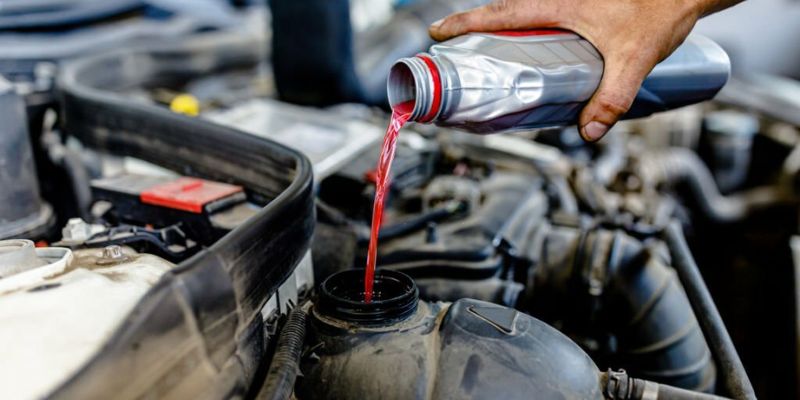When your vehicle’s coolant level drops, one key question arises—should the engine be on or off when refilling it? This article will provide a definitive answer.
We’ll overview how engine coolant works when to top it off, proper filling steps, plus tips for checking your levels safely with minimal mess. Additionally, you will know that does the car needs to be running when adding coolant and what are the risks of adding coolant when the engine is on.
Does the car need to be running when adding coolant?
No, it is recommended to add coolant with the engine off for safety and simplicity reasons.
Turning the car on is only necessary if checking fluid levels due to overheating concerns to supplement coolant when required. Otherwise, keep the engine off for the fastest top-ups.
How Does Engine Coolant Work?
Before addressing the drive state during fill-ups, let’s review what coolant does:
- Cools hot engine parts – It flows through passages around cylinders, absorbing and carrying away heat so components don’t overheat. This fluid circulation keeps operating temperatures steady.
- Prevents engine freeze-ups – Coolant contains liquid antifreeze that resists freezing in cold weather. This protects the engine block and components from cracking and warps below 32°F.
So in both hot and frigid conditions, proper coolant levels are vital for engine functioning and longevity.
When to Top Up Engine Coolant
Check coolant levels frequently per manufacturer recommendations (typically monthly inspections). Only supplement lost fluid as needed versus overfilling.
Signs you may need to top up coolant levels include:
- A low coolant warning light activates on the dash
- Overflow reservoir reads below “Full/Minimum” marks
- Signs of a leak like wetness around hose connections
Caution: Drastic coolant loss indicates serious leaks requiring repair by a professional. Small topping amounts between service intervals are normal.
Benefits of Adding Coolant with Engine Off
- Accessibility – It’s easier to remove caps and pour fluid with parts not dangerously hot.
- Observability – You can assess flow rates and stop pouring immediately once full.
- Controllability – No fluid spurting from open caps when fans kick on suddenly.
- Simplicity – Overall process quicker and cleaner without systems pressurized.
With the basics covered, let’s outline step-by-step directions for topping up lost coolant.
Dangers of Adding Coolant with Engine Running
Adding engine coolant while the car is on does carry some heightened risks compared to filling it off. This article will overview precautionary measures when checking hot levels and the potential hazards faced if proper protocols aren’t followed.
Wait for Adequate Cool Down First
Before even considering removing caps from hot pressurized systems, allow adequate cooling down. Antifreeze exceeds 200°F and coolant tanks reach similarly scalding temperatures.
Ambient cooling to below 100°F is recommended before touching any components. Steady idle rather than recently running also allows pressure relief. Rushed access risks:
Burn Hazards
Attempting to unscrew an overly hot pressurized cap leads to dangers like:
- Spurting liquid causing steam burns
- Contact with superheated components creates serious skin wounds
- Escaping steam vapors damage respiratory systems if inhaled
Caution must be exercised when working around live cooling systems. Be certain temperature gauges verify cooler operating conditions before proceeding.
Hazardous Spill Potential
Opening overflow reservoirs on running engines also raises risks like:
- Bumping caps causing overflow run-off splashing the engine
- Sudden eruption from loosened caps soaking surrounding accessories
- Losing your grip on the fluid jug leads to spills across components
Failing to stop the engine prevents controlling flow rates. This threatens hazardous slip scenarios which are amplified further on hot motor parts. Any spills require complete cleaning prior to restarting too.
How to Minimize Risks When Filling on Hot Engines
To mitigate the above dangers when checking overheating coolant on activated engines:
- Keep the vehicle in the park on level ground during the entire process. Engage parking brakes as well for added security against movement.
- Wear gloves that fully cover forearms and use cloth wraps on caps for grip and heat protection. Also, do safety goggles in case of fluid spray.
- Carefully position fill necks towards empty containers on standby to catch any overflow events or fast spurts of liquid.
- Exercise extreme patience and never rush any steps when relief valves show residual pressure. Allow full stabilization rather than over-loosening components quickly before fluid additions.
Following those conservative filling measures reduces but doesn’t eliminate, the risks that come with accessing hot operating systems. Still, adding coolant with the motor off remains inherently safer in most situations.
How to Safely Add Coolant
Follow these precautions and procedures whether the engine is on or off during the process:
- Wait for the engine to fully cool – Never open caps on any hot, pressurized systems. Serious burn threats exist.
- Wear gloves and eye protection – Guard hands and eyes when handling automotive fluids.
- Locate the coolant reservoir tank under the hood – Consult the vehicle guide if unsure (typically passenger side, rear engine).
- Relieve any residual pressure – Place rack over cap then slowly open to release leftover psi, allowing fluid cap removal.
- Remove the reservoir cap once fully depressurized.
- Add manufacturer-recommended coolant only to the “Full/Maximum” line. Mixing brands/types causes gel clumping from chemical interactions. Don’t overfill.
- Replace the cap tightly once done. Double-check the level on the indicator and top up if necessary.
- Dispose of any spilled liquids using oil dry or kitty litter. Check under the car for new leaks indicating a faulty hose or gasket.
- Run the engine once refilled to operating temperature, ensuring normal gauge readings. Turn the heater on high briefly to purge any trapped air inside.
And that’s all there is to it! Whether off or on, follow those tips when adding lost engine coolant for safe, simple top-ups.
Checking Coolant with Car Running (Overheating Concerns)
If your dashboard overheats warning activates:
- Pull over immediately and turn off the AC. Blast the heat instead which reduces the risk of cracking parts. Don’t remove the radiator cap until cooled or you’ll get severely burned.
- Monitor the temperature gauge descending once stopped and idling normally.
- If excess steam billows from under the hood indicating big leaks, have it towed versus driving and worsening damages. Call for roadside assistance.
However, if no obvious leaks or rupture noises, coolant loss may cause overheating. So:
- Wait until cooled completely before opening the cap.
- Check fluid level and top up if the inside overflow tank seems low. Having heat on previously creates lower-than-normal levels that you must now restore.
- Drive conservatively once refilled, reassessing overheating factors before going far. Schedule a repair shop inspection just in case.
Use these emergency coolant filling steps only when necessary during overheats. Otherwise, stick to procedures from earlier for routine top-ups.
Finding & Fixing the Source of Lost Coolant
If your car is losing coolant regularly you should find the source of the leak and fix it ASAP to avoid any overheating damages.
Causes of Lost Coolant
- External Leaks – Failed hoses, bad gaskets/seals on connections, loose fittings, cracks in reservoir. Creates wetness on components down below.
- Internal Leaks – Breaches inside the engine block or cylinder head. No external evidence leaks past outside. Causes overheating.
- Normal Evaporation – As antifreeze/water heats and cools in the system, some loss via vapor is expected over the years.
Finding the Source
- Check the ground underneath the car after sitting for accumulating fluid patches indicating external leaks. Watch hoses while the engine runs to spot seep points.
- Monitor coolant usage for abnormally frequent/fast loss hinting at internal leakage. Especially if there is no external evidence.
- Pressure test the cooling system annually to identify any hidden permeability issues leading to depleted levels.
Resolving Coolant Loss
- Tighten loose hose clamps or fasteners allowing seepage. Adjust fittings alignment if needed to improve gasket sealing.
- Replace outright any visibly cracked, weakened or mushy hoses prone to rupture.
- Reseal leaky gaskets using manufacturer-approved compounds like Hylomar, Copaslip, etc.
- Switch damaged water pump seals and oil cooler gaskets to prevent crossover contamination.
- Seek repairs for confirmed internal leaks within cylinder heads, heater core, engine block passages, and related. Requires teardowns to rebuild affected areas and prevent worse overheating or even hydrolock.
Following best practices when adding coolant is key, but finding and fixing the root cause of loss is equally important too. Neglecting leaks inevitably leads to engine damage or breakdowns over time.
Conclusion
Maintaining proper coolant fill levels is vital for engine functionality and longevity during all seasons. When topping up lost fluid:
Turn off car for the easiest, cleanest fills up to “Full” line
But run the engine to check/add fluid if already overheating
FAQ
Is it safe to remove the radiator cap when hot?
No, never remove the pressurized radiator cap until completely cooled. Serious burn dangers exist from spurting steam and fluid. Always wait until safe temperatures before opening.
How often should you check coolant levels?
Check engine coolant level monthly when filling up on gas. Look at reservoir tank marks to see if between “Add” and “Full” range—topping up as necessary from evaporation over time.
What if the oil appears in the coolant?
Signs of oil contamination signal potentially serious issues like head gasket breach or cracked engine block requiring immediate inspection. Don’t just continue “feeding” lost coolant without addressing root failures first.
Can you drive once the engine overheats?
Exercise extreme caution. Safely pull over, turn off the AC and heat on full, then monitor the temperature gauge descent before considering moving again IF level check reveals low coolant to refill. Tow truck if steam pours out indicating major leak or boil over instead of driving further.
Why does my car heater only blow cold air suddenly?
Likely coolant leaks lead to trapped air flow versus hot liquid circulation. Bleed out pockets by squeezing inlet hoses with heat maxed out and radiator cap off (once fully cooled). Then refill the tank to the “Full” mark after the purge is finished.

Hi, Michael Williams here. I have always loved everything with an engine. After earning my degree in automotive engineering, I spent 5 years testing vehicles for a major manufacturer in Illinois. Now I am using my technical skills to review the latest models online and help others troubleshoot their engine problems with effective solutions.
